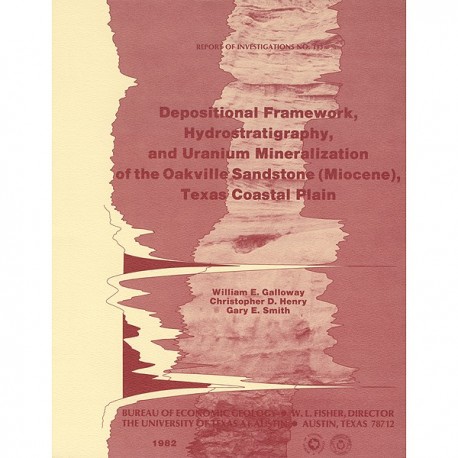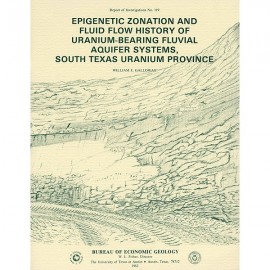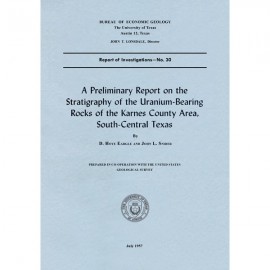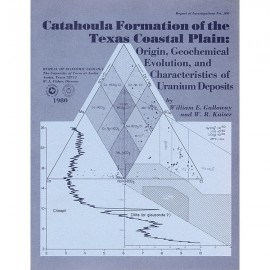Reports of Investigations
-
Books & Reports
- Reports of Investigations
- Guidebooks
- Udden Series
- Geological Circulars
- Down To Earth
- Atlases of Major Oil and Gas Reservoirs
- Texas Memorial Museum Publications
- Environmental Geologic Atlas of the Texas Coastal Zone
- Mineral Resource Circulars
- Other Reports
- Seminars and Workshops
- Handbooks
- Submerged Lands of Texas
- Symposia
- Annual Reports
- Open File Reports
-
Maps & Cross Sections
- Thematic Maps
- Miscellaneous Maps, Charts & Sections
- Geologic Atlas of Texas
- STATEMAP Project Maps
- Geologic Quadrangle Maps
- Cross Sections
- Highway Geology Map
- Energy and Mineral Resource Maps
- Shoreline Change and Other Posters
- Wilcox Group, East Texas, Geological / Hydrological Folios
- Bouguer Gravity Atlas of Texas
- River Basin Regional Studies
- Featured Maps
- Posters
- Teachers & the Public
-
Geological Society Publications
- Gulf Coast Association of Geological Societies
- Alabama Geological Society
- Austin Geological Society
- Corpus Christi Geological Society
- Houston Geological Society
- Lafayette Geological Society
- Mississippi Geological Society
- New Orleans Geological Society
- South Texas Geological Society
- GCS SEPM Publications
- Historic BEG & UT Series
Depositional Framework, Hydrostratigraphy, and Uranium Mineralization of the Oakville Sandstone (Miocene), Texas Coastal
RI0113
Depositional Framework, Hydrostratigraphy, and Uranium Mineralization of the Oakville Sandstone (Miocene), Texas Coastal Plain, by W. E. Galloway, C. D. Henry, and G. E. Smith. 51 p., 34 figs., 9 tables, 1982. ISSN: 0082-335X: Print Version.
A free, digital version of this publication can be found on: Texas ScholarWorks
RI0113. Depositional Framework, Hydrostratigraphy, and Uranium Mineralization of the Oakville Sandstone (Miocene), Texas Coastal Plain, by W. E. Galloway, C. D. Henry, and G. E. Smith. 51 p., 34 figs., 9 tables, 1982. ISSN: 0082-335X: Print.
To purchase this publication as a PDF download, please order RI0113D.
ABSTRACT
The Oakville Sandstone (Miocene) of the Texas Coastal Plain comprises a major sand-rich fluvial system composed of deposits of several major and minor rivers that originated within Texas and surrounding states. Broad bed-load fluvial axes, including the Hebbronville, George West, and New Davy trends, lie south of the San Marcos Arch and host significant reserves of uranium. To the north, the Moulton streamplain consists of deposits of numerous small, flashy to ephemeral streams that drained the inland margin of the Coastal Plain. The Burton/Penn mixed-load fluvial axes traverse the Coastal Plain in the area of the modern Colorado and Brazos Rivers.
Each fluvial axis consists of diagnostic facies deposited in channel, crevasse splay, and floodplain environments. Sand percentage, sand-body dimensions and lateral relationships, and vary systematically among the axes. Overall transmissivity of the Oakville Formation, which closely corresponds to the Jasper aquifer system in conventional hydrostratigraphic terminology, correlates directly with mapped facies composition and trend. Uranium deposit size relates directly to associated aquifer transmissivity.
Commercial uranium deposits lie within channel and interbedded sheet-splay sands in or along the margin of major fluvial belts, typically near shallow faults. Mineralization occurs along narrow, elongate fronts separating altered, but commonly resulfidized, host sand from epigenetically sulfidized reduced sand. Deposits show pronounced spatial zoning of trace metals and iron sulfide, carbonate, and locally, clay mineral phases across the mineralization front.
Keywords: deposition, hydrostratigraphy, uranium, mineralization, Oakville Formation, Miocene, Coastal Plain, Texas, Hebbronville, George West, New Davy, San Marcos Arch, Moulton streamplain, Texas
CONTENTS
Abstract
Introduction
Objectives and methodologies
The Gulf Coast artesian basin
Depositional framework of the Oakville aquifer
OAKVILLE DEPOSITIONAL SYSTEM
Hebbronville and George West fluvial axes
Conglomeratic bed-load channel-fill facies
Sandy bed-load channel-fill facies
Sheet-splay facies
Facies associations and distribution
New Davy fluvial axis
Conglomeratic bed-load channel- fill facies
Mixed-load channel-fill facies
Crevasse splay and sheet-splay facies
Facies associations and distribution
Moulton streamplain
Channel-fill facies
Sheet-splay and crevasse splay facies
Facies associations and distribution
Burton/Penn fluvial axes
Sinuous channel-fill facies
Crevasse splay and sheet-splay facies
Facies associations and distribution
Floodplain facies
Facies summary
MINERALOGIC COMPOSITION
Mudrock petrofacies
Sand petrofacies
SUMMARY OF GENETIC STRATIGRAPHY
Structural framework
FAULT DISTRIBUTION
IMPACTS ON HYDROGEOLOGY
Hydrostratigraphy
HYDROGEOLOGIC UNITS
AQUIFER TRANSMISSIVITY
Geology and geochemistry of Oakville uranium deposits
RAY POINT DISTRICT
Geochemical and mineralogical zonation
Ore paragenesis
GEORGE WEST DISTRICT
Geochemical and mineralogical
Ore paragenesis
Conclusions
Acknowledgments
References
Appendix A
Appendix B
Figures
1. Index map showing location of the study area, outcrop of the Oakville Sandstone, sample localities, and distribution of cross sections
2. Regional structural features of the Tertiary Gulf Coastal Plain and Edwards Plateau
3. Generalized offlapping stratigraphic sequence of the Texas Coastal Plain
4. Stratigraphic relationships of the Oakville Sandstone, Live Oak County
5. Net-sand isolith map of the Oakville Sandstone
6. Sand-percentage map of the Oakville Sandstone
7. Regional updip strike section illustrating facies of the Oakville fluvial system
8. Depositional elements of the Oakville fluvial system
9. Facies architecture of a composite sand belt of the George West fluvial axis
10. Line tracing showing a channel fill of the Ray Point fluvial axis
11. Line tracing illustrating structures and textures characteristic of the George West bed-load channel facies
12. Variation of the sandy bed-load channel-fill facies consisting of interstratified sand and mud-clast conglomerate
13. Schematic reconstruction of Oakville fluvialdepositional environments
14. Sheet-splay deposits of the George West axis exposed in the Smith uranium mine
15. Schematic facies architecture of a typical New Davy axis sand belt
16. Schematic facies architecture of a sand belt within the Moulton streamplain
17. Road cur displaying lateral accretion of a mixed-load channel of the Burton/Penn axes
18. Schematic facies architecture of a typical Burton/Penn axes sand belt
19. Compositional summary of Oakville sands
20. A. Euhedral sparry calcite porefill cement. B. Silica cement
21. Summary of genetic components and geometric and compositional characteristics of aquifer units within the Oakville depositional elements
22. Generalized distribution of faults and diapiric intrusions within or below the Oakville Sandstone
23. Stratigraphic dip sections comparing lithostratigraphic and hydrostratigraphic units
24. Geohydrologic data base used for pump test permeability data
25. Calculated permeabilities for major permeable facies belts
26. Regional transmissivity of the Oakville aquifer system
27. Schematic distribution of epigenetic zones within an oxidized aquifer
28. Geographic and geologic setting of the Ray Point district, Live Oak County
29. Cross section of the Oakville aquifer in the Ray Point district
30. Core transect of the Zamzow mineralization front
31. Paragenesis of the Zamzow mineralization front and associated geochemical zones
32. Cross section through the George West district
33. Geographic and geologic setting of the George West district, Live Oak County
34. Paragenesis of mineralization and associated zones along the southern alteration front, George West district
Tables
1. Clay mineralogyof representative fine-grained Oakville samples
2. Geochemical barriers capable of concentrating uranium and associated metals in ground-water flow systems
3. Summary of Oakville uranium-producing districts and areas
4. Compositional summary of Zamzow core cross section sample suite
5. Carbon isotope composition of selected Oakville samples
6. Compositional summary of George West district core sample suite
B-1. Analytical data for core samples, Zamzow mine site
B-2. Analytical data for core samples, George West deposit A
B-3. Analytical data for core samples, George West deposit B
Citation
Galloway, W. E., Henry, C. D., and Smith, G. E., 1982, Depositional Framework, Hydrostratigraphy, and Uranium Mineralization of the Oakville Sandstone (Miocene), Texas Coastal Plain: The University of Texas at Austin, Bureau of Economic Geology, Report of Investigations No. 113, 51 p.






